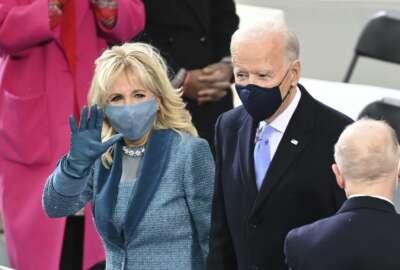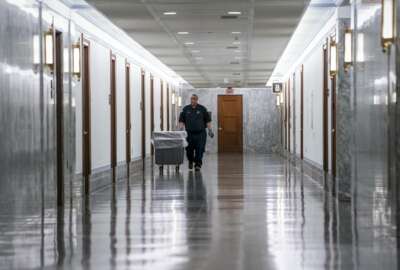
OMB details requirements of Biden’s new mask mandate for federal employees
Agencies have new guidance for implementing the president's new mask mandate from the Office of Management and Budget. According to the new guidance, "every effort...
Best listening experience is on Chrome, Firefox or Safari. Subscribe to Federal Drive’s daily audio interviews on Apple Podcasts or PodcastOne.
Masks and social distancing are required inside all federal buildings, and agencies must make “every effort” to maximize telework and limit the number of employees in federal buildings to no more than 25% of normal capacity, the Office of Management and Budget said Sunday.
The new OMB guidance is part of the administration’s efforts to implement President Joe Biden’s new mask mandate executive order.
The order, which the president signed on his first day in office, requires all federal employees, contractors and members of the public to wear a mask while inside executive branch buildings or on federal lands. It also establishes a new “safer federal workforce” task force, led by the director of the Office of Personnel Management, the administrator of the General Services Administration and White House COVID-19 response coordinator.
Many agencies have already established mask requirements and safety guidelines, and OMB under the Trump administration has provided pandemic guidance. Prior OMB guidance, however, focused mostly on resuming normal operations through a phased and localized process.
The new OMB guidance describes a series of “model safety principles,” which agencies should use to design COVID-19 workforce plans unique to their own organizations.
Agencies have until the end of the week to submit plans to OMB and the new safety task force for review. The task force, OMB said, will next work with agencies to finalize those plans.
The safety principles are a starting point, said Aviva Aron-Dine, the new OMB executive associate director, and more guidance will come at a later date and as conditions evolve.
“Of paramount concern is the health and safety of all federal employees and contractors and their families, and the administration is committed to taking a safe, cautious, iterative, data-driven approach,” she wrote.
OMB went on to describe its core safety principles. It directed agencies to outline which employees must work on-site or telework on a fulltime or part-time basis.
“As a general principle, every effort will be made to maximize the use of remote work during widespread community transmission,” the guidance reads. “Unless it is physically impossible or poses a threat to critical national security interests, generally speaking, occupancy in federal workplaces should be no more than 25% of normal capacity during periods of significant or high community transmission.”
Agencies must clear exceptions to the 25% cap with their top leadership and consult with the “safer federal workforce” task force, OMB said. In addition, agencies must give employees advance notice if their presence is required at the office, but the guidance didn’t detail how much time the workforce should receive.
As for face masks, all employees and contractors must wear one that covers the mouth and nose. Face shields aren’t a substitute for cloth masks, OMB said.
Agencies may buy their own masks to give to staff or visitors if they have available funding, but it’s not a requirement, OMB said. Those with sensory, cognitive or behavioral issues may have difficulty wearing a mask for an extended period of time, and agencies should make adaptations and alternatives available to them, OMB said.
Employees and contractors must wear a mask inside any common area or shared workspace, including conference rooms, open office spaces or cube embankments. Masks are also required outside when social distancing isn’t possible.
“Agencies may provide for exceptions consistent with Centers for Disease Control and Prevention guidelines, for example when an individual is alone in an office with floor to ceiling walls and a closed door or for a limited time when eating or drinking and maintaining distancing in accordance with CDC guidelines,” the guidance reads.
As for COVID-19 testing, the CDC is developing a plan for the federal workforce and will share it with agencies once it’s available, OMB said.
In the meantime, agencies should continue to limit visitors and official travel when necessary. Many agencies have created “cohorts” or staggered work hours to limit the number of employees in the office at a given time, and those arrangements should continue as well, OMB said.
The OMB guidance also tasks agency human resources or the assistant secretary for management team with supporting state and local contact tracing efforts. It also urged agencies to consider using web or mobile apps to check employee and visitor symptoms.
Anyone who develops symptoms during the workday should immediately leave the building and inform their supervisors, OMB said.
Beyond creating pandemic workforce plans, OMB wants each agency to create their own COVID-19 coordination teams. The teams should consist of an executive from each component agency, as well as leaders from human resources, occupational health and safety, general counsel and public safety. The new task force will appoint a public safety expert to agency coordination teams if they don’t have one in house, OMB said.
“The team is responsible for conducting assessments in order to establish, implement, and monitor compliance with: (a) safety protocols for physical space and masking; and (b) determinations of on site and telework/remote working,” OMB said. “The group should meet regularly to review compliance with agency COVID-19 workplace safety plans and protocols, consider potential revisions to agency COVID-19 workplace safety plans and protocols and any other operational needs.”
Copyright © 2025 Federal News Network. All rights reserved. This website is not intended for users located within the European Economic Area.
Nicole Ogrysko is a reporter for Federal News Network focusing on the federal workforce and federal pay and benefits.
Follow @nogryskoWFED




